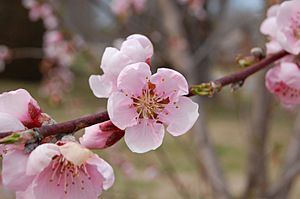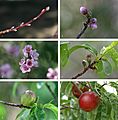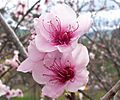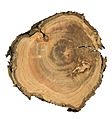Peach facts for kids
Quick facts for kids Peach |
|
|---|---|
 |
|
| Autumn Red peaches | |
| Scientific classification | |
| Kingdom: | |
| Division: | |
| Class: | |
| Order: | |
| Family: | |
| Genus: | |
| Subgenus: |
Amygdalus
|
| Species: |
P. persica
|
| Binomial name | |
| Prunus persica (L.) Batsch
|
|
The peach (Prunus persica) is a deciduous tree that originally came from Northwestern China. It grows a tasty, juicy fruit called a peach or a nectarine. People first started growing peaches in this part of China.
The name persica comes from Persia (which is now Iran). Peaches were grown a lot there before being brought to Europe. The peach belongs to the Prunus group of plants. This group also includes cherry trees, apricot trees, almond trees, and plum trees. They are all part of the rose family.
Peaches and nectarines are actually the same type of plant. But people usually see them as different fruits when they are sold. Peaches have a fuzzy skin. Nectarines do not have this fuzz. Scientists think a small change in one gene makes this difference.
In 2016, China grew more than half of all the peaches and nectarines in the world.
Contents
What Does a Peach Tree Look Like?
Peach blossoms are small to medium in size. A peach tree can grow up to 6.5 meters (21 feet) tall. But when people grow them, they usually keep them shorter. They prune the trees to be about 3 to 4 meters (10 to 13 feet) tall. The leaves are green and have a pointy shape. They often have special parts that make a liquid. This liquid helps to attract insects.
Peaches are known as stone fruits. This is because they have a very hard, woody shell around their seed. This shell is called a pit or a stone. The skin of a peach is usually orange or yellow. It is covered in tiny hairs, which people call peach fuzz. A peach without this fuzz is called a nectarine. The inside of a peach is a golden color. It tastes sweet and a bit sticky. Because they are so sweet, peaches are often used in desserts.
Peach Symbolism
The peach first came from China. People have been growing them there since at least 1000 B.C.E. In Chinese culture, the peach tree is seen as a tree of life. Peaches are also symbols of immortality, meaning living forever. Chinese brides sometimes carry peach blossoms.
How Long Do Peach Trees Live?
Peach trees usually live for about 10 to 12 years. This is because of cold winters, diseases, and pests. But if a peach tree gets enough fertilizer and is cared for well, it can live for more years.
Common Peach Tree Problems
Peach trees can get sick or be bothered by insects. Here are some common problems:
Brown Rot Disease
Brown rot is a very serious peach disease. It can harm the blossoms and stop the fruit from growing. If this disease is not stopped quickly, the peach tree will not produce good fruit.
Peach Leaf Curl Disease
Peach leaf curl is another serious disease. It makes the leaves curl up and start to die in spring. You can stop it with a special spray called fungicide.
Bacterial Spot Disease
Bacterial spot harms the leaves, twigs, and fruit. By the time you notice this disease, it is often too late to stop it. But some sprays can be used early next season to help protect the tree.
Cankers Disease
Cankers is a disease that affects the twigs and branches. It causes a lot of sticky, amber-colored sap to leak out. Later, the bark cracks open, and the twig inside turns black. You can remove cankers by pruning the affected parts.
Insect Pests
Many kinds of insects can cause big problems for peaches.
- The Oriental fruit moth can make peaches full of worms. It can also make young growing tips die.
- The plum curculio lays its eggs on the fruit. This makes the fruit drop off or become full of worms.
- Insects like the tarnished plant bug and the stink bug eat the fruit while it is still growing.
- Borers are insects that attack the bottom of the tree trunk and its branches.
Images for kids
-
Dried date, peach, apricot, and stones from Lahun, Fayum, Egypt, Late Middle Kingdom, Petrie Museum of Egyptian Archaeology, London
-
A peach flower with a bee pollinating it
-
The developmental sequence of a nectarine over a 7+1⁄2-month period, from bud formation in early winter to fruit ripening in midsummer
-
Pierre-Auguste Renoir, A Still Life Painting of Peaches, 1881–82
-
Portrait of Isabella and John Stewart by Charles Willson Peale, 1774
-
A Jar of Peaches by Claude Monet c. 1866
See also
 In Spanish: Melocotonero para niños
In Spanish: Melocotonero para niños



















